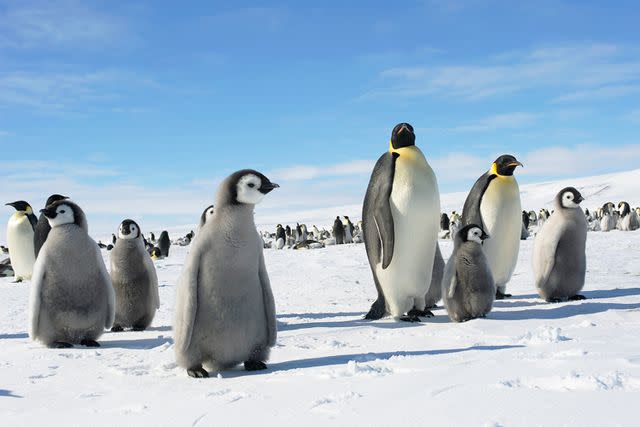New Colonies of Emperor Penguin Discovered Thanks to Bird Poop Seen from Outer Space
Antarctic researchers discovered four new colonies of the near-threatened emperor penguin species via satellite images of the birds' poop

Wolfgang Kaehler/LightRocket/Getty
Stock photo of emperor penguinsPenguin poop that is visible from space helped a scientist discover four new colonies of emperor penguins — a species threatened by extinction.
NBC News reported on Wednesday that the discovery, made by a research scientist at the British Antarctic Survey (BAS) named Peter Fretwell, is exciting, but doesn't necessarily improve the species' predicted fate.
Fretwell, a geographic information officer at the BAS, spotted the patches of penguin poop (also called "guano," the technical term for bird poop) using satellite imagery. They showed up in the pictures as "brown smudges."
Per the World Wildlife Foundation (WWF), there are only about 600,000 emperor penguins still alive today. Their population has dropped about 50% in the last half-century. They are classified as a "near threatened" species.

Wolfgang Kaehler/LightRocket/Getty
Stock photo of an emperor penguin colonyNever miss a story — sign up for PEOPLE's free daily newsletter to stay up-to-date on the best of what PEOPLE has to offer, from celebrity news to compelling human interest stories.
“By the end of the century we think that almost all emperor penguin colonies will no longer be viable,” Fretwell told NBC News. “They’re not going to survive in the long run.”
Fretwell said that the newly discovered colonies have probably been alive for many years, but just hadn't been found yet.
The images he procured showed that some of these newly discovered colonies are moving as the weather changes in Antarctica. Climate change is causing the sea-ice habitats where the penguins breed and seek food and shelter to melt rapidly.
Satellite images help scientists track emperor penguin behavior as their habitat continues to be threatened.
As Fretwell wrote of his guano images in the journal Antarctic Science on Saturday, his discovery provides scientists with "an idea of the distribution and where the colonies are, and that’s really, really important if we’re going to monitor how they adapt to climate change,” he said. “But it doesn’t change the big picture that much.”
Per NBC News, emperor penguins have one of the most unique and dangerous breeding practices in the world. They breed at the coldest time of year in Antarctica, when "temperatures near minus 50 Fahrenheit and Antarctic winds howl at 120 mph" so that their chicks are born and can grow in warmer months.

Wolfgang Kaehler/LightRocket/Getty
Stock photo of emperor penguins on Snow Hill Island in Antarctica's Weddell SeaRelated: Penguin Causes Delays at New Zealand Airport: ‘A Very Unusual Little Visitor’
Male penguins balance the eggs on their feet to keep them warm. They rotate in a huddle with as many as 5,000 members of their colony so that everyone has a chance to be on the inside of the formation, presumably the warmest spot.
The number of emperor penguin colonies known to scientists has now grown from 62 to 66 with Fretwell's discovery.
For more People news, make sure to sign up for our newsletter!
Read the original article on People.

